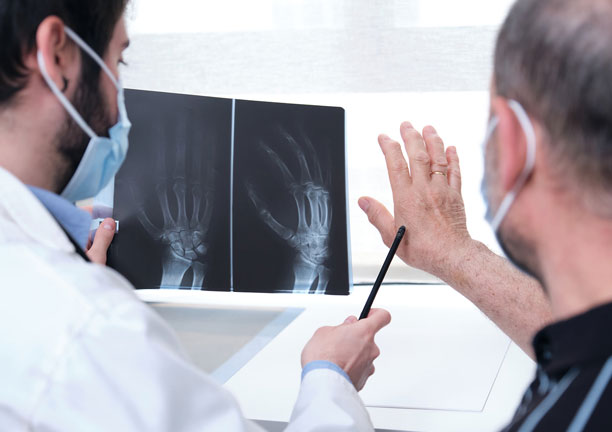Medically Reviewed by Dr. Angelo Ciminiello
Key Takeaways
- Osteoarthritis progresses in four stages, from minor wear to severe joint damage.
- Symptoms worsen over time but can often be managed with early intervention.
- Weight-bearing joints like the knees, hips, and spine are most affected.
- Treatment options range from lifestyle changes to surgery in later stages.
Are you experiencing joint pain or stiffness and want to understand the progression of osteoarthritis?
Osteoarthritis(OA) is a degenerative joint disease that results from the gradual breakdown of joint cartilage, which cushions the ends of bones and allows them to move smoothly against each other. As the cartilage wears down, bones may rub against each other, causing pain, stiffness, swelling, and other symptoms.
OA can affect any joint, but it most commonly occurs in weight-bearing joints such as the hips, knees, and spine, as well as in the hands and feet. The exact cause of OA is not fully understood, but it is thought to be a combination of factors, including aging, genetics, previous joint injuries, and obesity.
There is no cure for OA, but treatments such as pain management, physical therapy, and lifestyle modifications can help manage symptoms and slow the progression of the disease. In severe cases, joint replacement surgery may be necessary.
The Four Stages
Osteoarthritis is a degenerative joint disease that typically progresses slowly over time. There are generally four stages of osteoarthritis. Please note that not every person with osteoarthritis will experience all four stages, and the progression can be different for different people.
Also, it’s always recommended to consult with a medical professional to determine the appropriate treatment options. Here are the signs and symptoms, diagnosis, and treatment options for each stage of osteoarthritis:
Stage 1: Minor
Signs and symptoms: Minor wear and tear in the joint with minimal symptoms, such as mild pain, stiffness, or swelling after physical activity. There may be slight joint space narrowing visible on X-rays.
Diagnosis: Physical examination, X-rays, and MRI may be used to confirm the diagnosis and assess the degree of cartilage damage.
Treatment: Treatment options may include lifestyle modifications like losing weight, exercising, and avoiding activities that put stress on the joint. Over-the-counter pain medications like acetaminophen or nonsteroidal anti-inflammatory drugs (NSAIDs) may also be recommended.
Stage 2: Mild
Signs and symptoms: Further deterioration of joint cartilage, with noticeable decrease in joint space on X-rays. Symptoms may include more frequent pain, stiffness, and swelling, particularly after physical activity.
Diagnosis: Diagnosis is usually based on the presence of joint symptoms and imaging tests like X-rays and MRIs.
Treatment: Treatment options may include physical therapy, joint injections of corticosteroids or hyaluronic acid, and the use of assistive devices like braces or shoe inserts. Over-the-counter pain medications or prescription NSAIDs may also be recommended.
Stage 3: Moderate
Signs and symptoms: Significant cartilage deterioration resulting in more pronounced pain, stiffness, and swelling that may affect normal everyday activities. Bone spurs may start to develop and joint deformity may become apparent. Joint space narrowing is significant on X-rays.
Diagnosis: Physical examination, X-rays, and MRI may be used to confirm the diagnosis and assess the degree of cartilage damage.
Treatment: Treatment options may include all of the above treatments as well as prescription pain medications, exercise programs, and surgery for joint realignment or joint replacement.
Stage 4: Severe
Signs and symptoms: Advanced joint degeneration with significant joint space narrowing, extensive cartilage loss, and bone-on-bone contact. Pain, stiffness, and swelling are severe and constant, limiting mobility and impairing quality of life. Joint deformity is typically present, and bone spurs may be large and prominent.
Diagnosis: Physical examination, X-rays, and MRI may be used to confirm the diagnosis and assess the degree of cartilage damage.
Treatment: Treatment options may include all of the above treatments as well as joint replacement surgery. Joint replacement surgery involves removing the damaged joint and replacing it with an artificial joint. Rehabilitation is necessary following joint replacement surgery to restore range of motion, strength, and function.
Causes of Osteoarthritis Flare Ups
There are several factors that can cause an osteoarthritis flare-up, which is a sudden increase in pain and stiffness in the affected joint. These include:
- Overuse or injury: Repeated use of a joint or a sudden injury can cause inflammation and aggravate OA symptoms.
- Inactivity: Prolonged periods of inactivity can weaken the muscles around a joint and lead to stiffness and pain.
- Changes in weather: Changes in temperature, humidity, or barometric pressure can trigger inflammation and exacerbate OA symptoms.
- Weight gain: Excess weight puts additional stress on joints, which can cause increased pain and inflammation.
- Medications: Some medications can cause side effects that worsen OA symptoms, such as corticosteroids or blood pressure medications.
- Stress: Stress can cause inflammation and exacerbate pain in people with OA.
- Diet: Certain foods, such as those high in sugar, refined carbohydrates, or trans fats, can cause inflammation and worsen OA symptoms.
Note that the triggers for OA flare-ups can vary from person to person, and it may take some trial and error to identify what triggers your symptoms. By paying attention to your body and keeping track of any flare-ups, you can work with your doctor to develop a plan to manage your OA symptoms.
How Quickly Does Osteoarthritis Spread?
The progression of osteoarthritis can vary from person to person and can depend on a variety of factors, such as the location of the affected joint, the degree of cartilage damage, and the person’s overall health. In some cases, osteoarthritis may progress slowly over many years, while in others it may progress more quickly.
Risk factors that can accelerate the progression of osteoarthritis include obesity, which puts extra stress on the joints, and a history of joint injury, which can cause damage to the cartilage. Other factors that can influence the progression of osteoarthritis include age, genetics, and overall health.
It’s important to note that, even with advanced osteoarthritis, the joint may not necessarily become stiff and immobile. With the help of physical therapy, medication, and other treatments, people with osteoarthritis can often continue to maintain a good range of motion and function in their affected joints.
Is there anything else I need to know about the dangers of osteoarthritis?
In addition to the progression of the disease and the impact it can have on mobility and quality of life, there are a few other potential dangers associated with osteoarthritis:
- Increased risk of falls: People with osteoarthritis may be at higher risk for falls due to joint pain, stiffness, and reduced mobility. This can lead to fractures, head injuries, and other serious complications.
- Joint deformities: In severe cases of osteoarthritis, the joint can become deformed and misaligned, leading to further pain and mobility problems.
- Secondary conditions: People with osteoarthritis may be at increased risk for developing other conditions, such as depression, sleep disorders, and cardiovascular disease.
- Side effects of treatment: Some treatments for osteoarthritis, such as corticosteroid injections or oral NSAIDs, can have side effects like gastrointestinal bleeding or increased risk of infection.
It’s important to work closely with a healthcare provider to manage osteoarthritis and minimize these potential risks. This may involve a combination of medication, lifestyle modifications, and possibly surgery for severe cases. Physical therapy and occupational therapy can also be helpful for improving mobility and reducing the risk of falls.
FAQs
Mild joint stiffness, slight pain after activity, or swelling in joints are often early signs of osteoarthritis.
While OA can’t be reversed, lifestyle changes and treatment can slow its progression significantly.
If pain is constant and mobility is limited even after conservative treatment, surgery may be the next step.
Not always. Many people manage their OA in the early stages for years with non-surgical treatments.
Yes, especially if risk factors like obesity or repetitive strain aren’t managed.



















